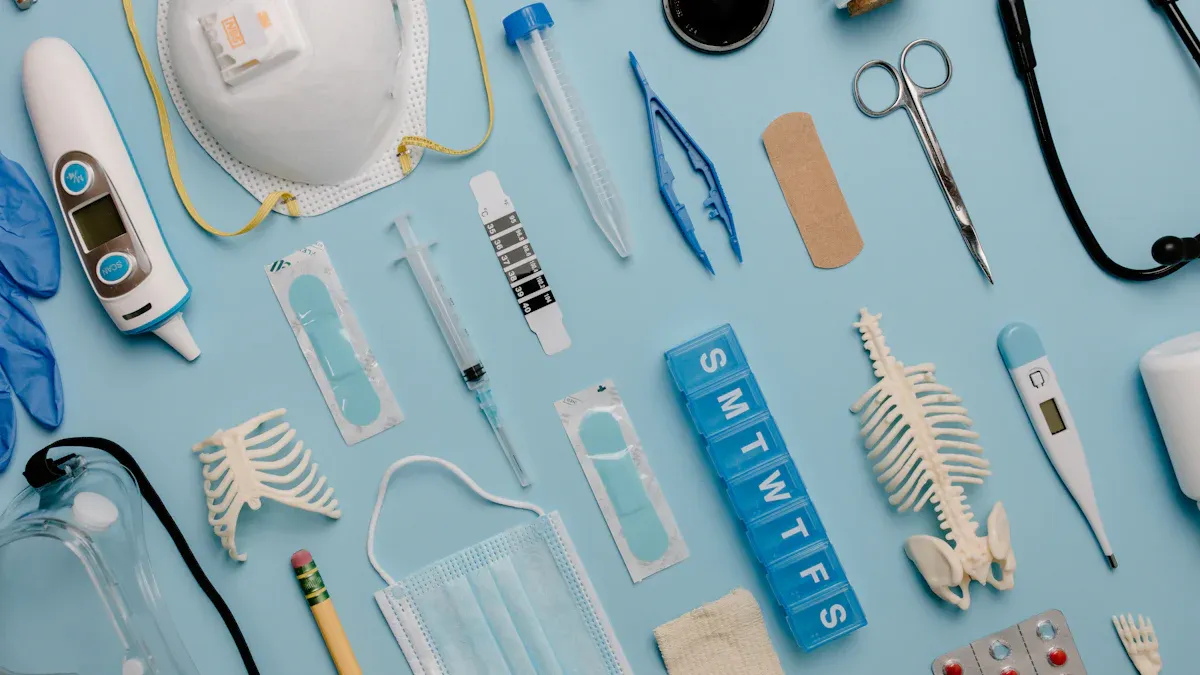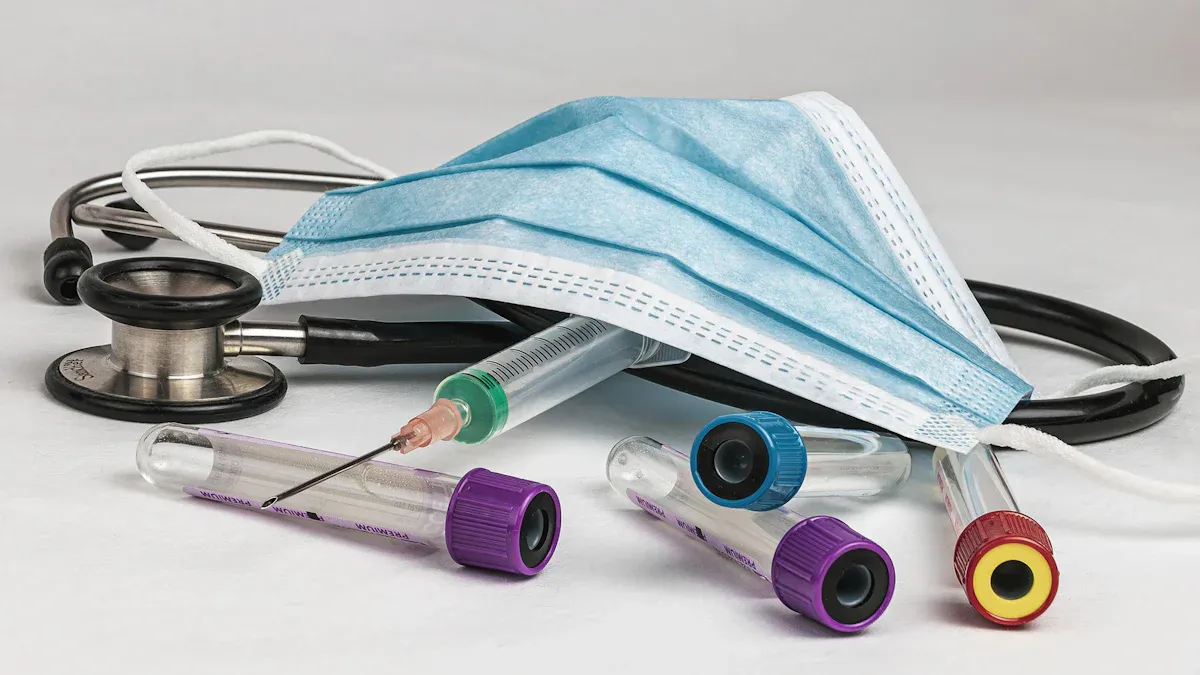How Surface Treatments Enhance Medical Nitinol Tubing Performance

Surface treatments play a vital role in enhancing the functionality of nitinol tubing used in medical devices, making them the best surface treatment for medical nitinol tubing. These advanced processes improve biocompatibility, hemocompatibility, and deliverability, ensuring greater safety and effectiveness in healthcare applications. By modifying the surface properties, treatments minimize risks like ion leaching and blood clot formation, which can compromise device performance.
Statistical studies reveal that corrosion resistance improves significantly with optimized surface areas, particularly smaller ones ranging from 0.05 to 2.00 cm². This demonstrates how surface modifications directly impact the biostability and durability of nitinol. These enhancements also reduce the impact on functionality caused by harsh biological environments, ensuring long-term reliability.
Surface treatments not only improve the safety of medical tubing but also promote better tissue integration. This makes them indispensable in creating medical devices that perform seamlessly within the human body.
Key Takeaways
Surface treatments make medical nitinol tubing safer and work better. They help it fit with the body and lower risks like blood clots.
Electropolishing makes the surface smoother. This helps it last longer and lowers the chance of blood clots, making it safer for medical use.
Parylene coatings make devices slide in easier. This makes patients more comfortable and helps devices work smoothly.
Plasma treatments improve the surface, helping it connect with tissue better. They also lower the chance of breaks in medical implants.
Surface treatments help nitinol devices last longer. They stop rust and reduce damage during use.
Best Surface Treatment for Medical Nitinol Tubing
Electropolishing for a smoother, defect-free surface
Electropolishing is a widely recognized method for achieving a superior surface finish of nitinol. This process removes surface irregularities, resulting in a smoother and defect-free surface. Studies show that electropolishing can improve the average surface roughness (Ra) by 75%, achieving values as low as 0.5 μm. The process typically operates at a potential of 4 V, lasts for 30 minutes, and maintains a temperature of 40 °C. These conditions not only enhance the surface finish of nitinol but also improve its fatigue life by approximately 20% under low stress conditions (570 MPa).
Measurable Outcome | Value |
|---|---|
Improvement in average surface roughness (Ra) | 75% improvement compared to as-built Ra |
Best Ra value achieved | Less than 0.5 μm |
Electropolishing potential | 4 V |
Duration of process | 30 min |
Temperature during process | 40 °C |
Improvement in fatigue life | Approximately 20% at low stresses (570 MPa) |
Electropolishing ensures the safety and reliability of medical tubing by eliminating surface defects that could compromise device performance. This makes it an optimal surface treatment for medical nitinol tubing.
Parylene coating to reduce intervascular friction
Parylene coatings are another effective solution for enhancing the surface finish of nitinol. These coatings create a smooth, biocompatible layer that reduces intervascular friction, improving the deliverability of medical devices. Devices such as stents, catheters, and orthopedic implants benefit significantly from this treatment. Parylene not only enhances the performance of nitinol tubing but also improves patient comfort by minimizing irritation during device deployment. Its application demonstrates how surface treatments and coatings can optimize the functionality of medical tubing in critical healthcare scenarios.
Plasma and laser treatments for enhanced surface properties
Plasma and laser treatments offer advanced solutions for modifying the surface finish of nitinol. Pulse plasma nitriding, in particular, has proven effective in enhancing the surface properties of medical nitinol tubing. This precision-controlled process ensures consistent and uniform results, which are essential for the reliability of medical implants. Improved surface smoothness achieved through plasma treatments reduces the risk of fractures in applications like artificial joints. These treatments also enhance the biocompatibility and durability of nitinol, making them indispensable for high-performance medical devices.
By combining these advanced techniques, AccuPath ensures that its nitinol tubing meets the highest standards of quality and safety. These surface treatments and coatings not only improve the surface finish of nitinol but also enhance its overall performance in medical applications.
Enhancing Biocompatibility and Hemocompatibility

Reducing thrombogenicity for blood-contacting devices
Thrombogenicity poses a significant challenge for blood-contacting medical devices. Surface treatments play a crucial role in addressing this issue by modifying the surface properties of nitinol. Electropolishing, for instance, creates a smoother and more uniform surface, which reduces the likelihood of blood clot formation. Clinical studies have shown that electropolished nitinol exhibits a lower thrombotic response compared to untreated samples. This improvement stems from the removal of surface irregularities that can trigger clotting.
Additionally, blue oxide coatings have demonstrated enhanced hemocompatibility and thrombogenicity reduction. These coatings minimize the interaction between the device and blood components, ensuring safer and more reliable performance. By reducing thrombogenicity, surface treatments contribute to the development of medical tubing that meets the highest safety standards for blood-contacting applications.
Minimizing protein adsorption to improve device performance
Protein adsorption on the surface of nitinol devices can compromise their functionality and lead to adverse biological reactions. Surface modifications, such as electropolishing and plasma treatments, effectively minimize protein adsorption. Research indicates that electropolished nitinol surfaces exhibit lower protein adhesion compared to untreated ones. This reduction enhances hemocompatibility and improves the overall performance of medical devices.
A thinner oxide layer, achieved through electropolishing, plays a key role in reducing protein adsorption. This layer prevents proteins from binding to the surface, thereby maintaining the device's optimal functionality. For instance, in vitro evaluations have shown that electropolished nitinol samples with blue oxide coatings demonstrate trends toward lower protein adsorption. These findings highlight the importance of surface treatments in optimizing device performance and ensuring long-term reliability.
Evidence Description | Findings | Source |
|---|---|---|
Electropolishing of Nitinol implants resulted in a thinner oxide layer, correlated with lower nickel release and higher corrosion resistance. | Thinner oxide layer led to reduced nickel concentration and corrosion, enhancing biocompatibility. | Sullivan et al. |
In vitro evaluation showed trends toward lower protein adsorption in electropolished/blue oxide samples. | Suggests improved hemocompatibility due to reduced protein adhesion. | Clarke et al. |
Lower thrombotic response observed in electropolished/blue oxide compared to native Nitinol. | Indicates enhanced hemocompatibility through surface modification. | Previous studies |
Modifying surface charges for better tissue interaction
Surface charge modification is another critical aspect of enhancing the biocompatibility of nitinol devices. By altering the surface charge, treatments can improve the interaction between the device and surrounding tissue. Plasma treatments, for example, allow precise control over surface charges, promoting better integration with biological environments.
Positive or negative charges on the surface influence how cells and proteins interact with the device. A well-modified surface charge can encourage tissue healing and reduce adverse reactions. This approach is particularly beneficial for implants and stents, where seamless tissue integration is essential for optimal device performance. Surface charge modification ensures that nitinol devices not only function effectively but also support the body's natural healing processes.
Improving Corrosion Resistance
Eliminating Ni-rich layers to prevent ion leaching
The presence of nickel-rich (Ni-rich) layers on nitinol surfaces poses a significant challenge for corrosion resistance and biocompatibility. These layers can lead to ion leaching, which increases the risk of adverse biological reactions, particularly in blood-contacting medical devices. Surface treatments like electropolishing effectively remove these Ni-rich regions, creating a more uniform and stable oxide layer. This process not only enhances the corrosion resistance of nitinol but also minimizes nickel release, ensuring greater safety for patients.
Research highlights the importance of eliminating Ni-rich layers in medical tubing. Polished nitinol stents, for example, exhibit superior pitting corrosion resistance compared to unpolished ones. By removing these nickel-rich areas, surface treatments reduce the likelihood of ion leaching, making nitinol-based devices safer and more reliable for long-term use in the human body.
Enhancing durability in harsh biological environments
Nitinol medical tubing often operates in challenging biological environments, where exposure to bodily fluids and varying pH levels can compromise its performance. Surface treatments play a critical role in enhancing the durability of nitinol under these conditions. Processes like low-temperature aging and cold work improve the mechanical properties and fatigue life of nitinol implants, ensuring they maintain their functionality over extended periods.
Studies show that treated nitinol exhibits remarkable durability in harsh environments. For instance:
Surface treatments improve the oxide layer, which acts as a protective barrier against corrosion.
A smoother surface reduces initiation points for corrosion, further enhancing resistance.
Low-temperature aging enhances fatigue life, making nitinol more resilient to mechanical stress.
These advancements ensure that nitinol devices remain reliable and effective, even in the most demanding biological settings.
Protecting against chemical and biological degradation
Chemical and biological degradation can significantly impact the performance of nitinol medical tubing. Surface treatments provide a robust defense against these threats by creating a stable and protective oxide layer. This layer prevents the penetration of harmful substances, reducing the risk of corrosion and degradation over time.
Electropolishing and passivation are particularly effective in protecting nitinol from chemical and biological damage. These treatments enhance the surface finish, eliminating defects that could serve as entry points for corrosive agents. Additionally, the improved oxide layer minimizes interactions with blood and other biological fluids, further enhancing the safety and longevity of nitinol devices.
By addressing these challenges, surface treatments ensure that nitinol medical tubing maintains its structural integrity and functionality throughout its lifespan. This makes it an indispensable material for a wide range of medical applications.
Promoting Endothelialization and Tissue Integration
Optimizing surface texture for cell adhesion
Surface texture plays a critical role in encouraging cell adhesion, which is essential for endothelialization and tissue integration. Treatments like electropolishing and plasma modification create smoother surfaces that reduce irregularities. These refined surfaces provide an ideal environment for cells to attach and grow. Research shows that smoother surfaces also minimize blood clot formation, enhancing the safety and functionality of medical tubing.
Additionally, surface roughness can be tailored to promote specific cellular responses. For example, micro- and nano-scale textures can improve the adhesion of endothelial cells, which are vital for vascular applications. By optimizing surface texture, medical tubing achieves better integration with surrounding tissues, ensuring long-term performance and reliability.
Supporting endothelial cell growth for vascular compatibility
Endothelial cell growth is a cornerstone of vascular compatibility. Surface treatments enhance this process by creating conditions that support cell adherence and proliferation. Studies demonstrate that treated surfaces, such as those modified with avidin-biotin systems, significantly improve endothelial cell attachment and growth.
Evidence Description | Findings |
|---|---|
Reduction of neointima-to-media areas ratio in treated arteries | 30% reduction observed in animals with avidin-modified stents and biotinylated RAEC compared to BMS-treated arteries |
Endothelial cell adherence and proliferation | Cells adhered to metal substrates and proliferated under both flow and no flow conditions, with varying survival rates post-stent expansion |
Efficient attachment of biotin-modified cells | Biotinylated EC showed more efficient attachment to avidin-coated surfaces compared to fibronectin-only surfaces |
Enhanced cell seeding under stationary conditions | Stationary conditions yielded better attachment of biotinylated RAEC to avidin-modified steel surfaces under shear stress conditions |
These findings highlight the importance of surface treatments in fostering endothelialization. By supporting endothelial cell growth, medical tubing becomes more compatible with vascular environments, reducing complications and improving patient outcomes.
Encouraging tissue healing and integration with implants
Surface treatments not only enhance endothelialization but also promote tissue healing and integration with implants. Advanced coating technologies reduce nickel ion release, minimizing allergic reactions and improving biocompatibility. Electropolishing and plasma treatments further contribute by creating smoother surfaces that encourage endothelialization and decrease thrombogenicity.
Surface treatments are crucial for enhancing the biocompatibility of nitinol stent tubing.
Advanced coating technologies minimize nickel ion release, which helps reduce allergic reactions.
Electropolishing and plasma treatments create smoother surfaces that promote endothelialization and decrease thrombogenicity.
These processes ensure that implants integrate seamlessly with surrounding tissues, reducing inflammation and promoting healing. By addressing both biocompatibility and functionality, surface treatments play a pivotal role in the success of nitinol-based medical devices.
Reducing Friction and Enhancing Deliverability

Smoothing surfaces for easier device insertion
Surface treatments play a vital role in improving device insertion by creating smoother surfaces on medical nitinol tubing. Electropolishing and plasma treatments refine the surface, eliminating irregularities that could hinder insertion. A smoother surface reduces friction between the tubing and surrounding tissues, ensuring safer and more efficient deployment. This improvement is particularly beneficial for catheters, which require precise placement in delicate anatomical regions.
By reducing surface roughness, treatments enhance the deliverability of medical tubing. Devices glide more easily through narrow pathways, minimizing the risk of damage to tissues. This smoother interaction also improves patient comfort during procedures, making surface treatments indispensable for enhancing device functionality.
Improving maneuverability in complex anatomical pathways
Medical tubing often navigates intricate anatomical structures, such as blood vessels and internal organs. Surface treatments optimize maneuverability by enhancing the flexibility and durability of nitinol. These properties allow devices like catheters to adapt to complex pathways without compromising their performance.
Shape memory characteristics further improve deliverability by enabling the tubing to revert to its original shape after deformation. This ensures consistent functionality during delicate procedures. Enhanced navigation leads to precise placement and movement within the body, increasing success rates in medical interventions.
Evidence Description | Key Performance Metrics |
|---|---|
Nitinol's flexibility and durability enhance navigation through complex structures. | Improved maneuverability and control during medical procedures. |
Shape memory properties allow guidewire to revert to original shape after deformation. | Consistent performance and reliability in delicate medical procedures. |
Enhanced navigation leads to precise placement and movement within the body. | Increased success rates in medical interventions due to better maneuverability. |
These advancements highlight the importance of surface treatments in improving device deliverability for challenging medical applications.
Reducing wear and tear during device deployment
Surface treatments also protect medical tubing from wear and tear during deployment. Procedures often involve repeated movements and exposure to biological environments, which can degrade untreated surfaces. Electropolishing and parylene coatings create durable layers that resist mechanical stress and corrosion.
Catheters benefit significantly from these treatments, as they endure frequent use in demanding conditions. A smoother and more resilient surface reduces friction, preventing damage to both the tubing and surrounding tissues. This durability ensures the tubing maintains its functionality over time, contributing to safer and more reliable medical procedures.
Surface treatments not only enhance the deliverability of medical tubing but also extend its lifespan. By reducing wear and tear, they ensure devices perform effectively in critical healthcare scenarios.
Surface treatments play a transformative role in enhancing the performance of medical nitinol tubing. By refining the surface, these treatments improve biocompatibility, reduce corrosion, and promote better tissue integration. They also enhance the functionality of devices by ensuring smoother deliverability and reducing wear during use.
Future advancements in surface treatment technologies, such as electrochemical polishing and plasma treatment, promise even greater benefits. These innovations are expected to extend the lifespan of nitinol-based devices by up to 30%, while minimizing adverse patient reactions. As medical technology evolves, the importance of surface treatments will continue to grow, driving innovation and ensuring safer, more effective medical devices.
FAQ
What is the primary purpose of surface treatments for medical nitinol tubing?
Surface treatments optimize the tubing's performance by enhancing biocompatibility, corrosion resistance, and deliverability. These modifications ensure safer and more effective medical devices, reducing risks like ion leaching and blood clot formation.
How does electropolishing improve nitinol tubing?
Electropolishing removes surface defects, creating a smoother finish. This process enhances fatigue life, reduces thrombogenicity, and minimizes protein adsorption, making the tubing safer and more reliable for medical applications.
Are surface treatments necessary for all nitinol-based devices?
Yes, surface treatments are essential for devices exposed to biological environments. They improve durability, biocompatibility, and tissue integration, ensuring the tubing performs effectively and safely within the human body.
Can surface treatments reduce nickel ion release?
Yes, treatments like electropolishing eliminate nickel-rich layers, reducing ion leaching. This minimizes allergic reactions and enhances the biocompatibility of nitinol tubing, especially for blood-contacting devices.
Do surface treatments affect device deliverability?
Surface treatments improve deliverability by smoothing the tubing's surface. This reduces friction, enhances maneuverability in complex pathways, and prevents wear during deployment, ensuring precise and efficient device placement.
See Also
Nitinol Tubing's Impact on Transforming Medical Equipment
Nitinol Tubing's Contribution to Progressing Medical Innovations
The Importance of Nitinol Tubing in Modern Medical Uses
The Process of Creating Nitinol Tubing for Healthcare
Investigating Nitinol Tubing Uses in Medical Device Development

